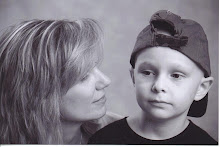About Me

- Name: Ryan
- Location: Athens, Ga, United States
Our son Ryan was diagnosed with stage 4 Neuroblastoma in 2004. In 2007, my wife Missy was diagnosed with stage 2 triple negative breast cancer. On July 8th, 2009, Missy lost her battle to this horrible disease. 2 days later, on July 10th, Ryan also lost his. Together forever, they both watch over our family now from the heavens above. Below is our families journey through Ryan's treatments, along with the joy and laughter we tried to instill into our daily lives. Those days helped us all cope with the pain and suffering that comes with cancer and it's deadly treatments. Both Missy and Ryan endured high doses of chemo, radiation and surgeries. Over 150 nights spent in the hospital and many, many more days. More transfusions than I could count. Yet both Missy and Ryan took on each day with a positive attitude and warm smile for all their friends. We miss them terribly. They will always be a shining light in our lives.
Wednesday, May 13, 2009
Detox is a terrible, terrible process
But on the positive side...I just can't believe how quickly we were able to eliminate the pain medicine after starting the Nifurtimox. He has had no sign of the pain that was virtually disabling just last week ! It is just amazing. We will keep him on this program and slowly convince him he has to return to Vermont in a few weeks. Once he is feeling better, that shouldn't be too difficult. Please keep Ryan and Missy in your thoughts and prayers. Sincerely, Les, Missy, Heidi, Will and SuperRyan
Love you. Dorie
One area of particular interest is high-risk neuroblastoma, a solid tumor of the sympathetic nervous system. Although cure rates for children with low and moderate risk neuroblastoma are about 90 percent, cure rates for high-risk neuroblastoma are only about 45 percent.
High-risk neuroblastoma is currently treated with surgery to remove as much of the tumor as possible and high-dose chemotherapy followed by a stem cell transplant with stem cells taken from the patient's own blood before chemotherapy.
When stem cell transplant was added to treatment for high-risk neuroblastoma, it increased survival by about 10 percent, says Dr. Ozkaynak. COG is now investigating whether two, back-to-back stem cell transplants would improve survival even further.
As Vice Chairman of a COG neuroblastoma protocol, Dr. Ozkaynak and his colleagues are also investigating immunotherapy approaches. For example, they are testing whether adding an antibody (chimeric anti-GD2) that specifically targets neuroblastoma cells to cis-retinoic acid, a substance that appears to make cancer cells differentiate into mature, normal sympathetic nervous system cells, will lead to better cancer control.
<< Home

